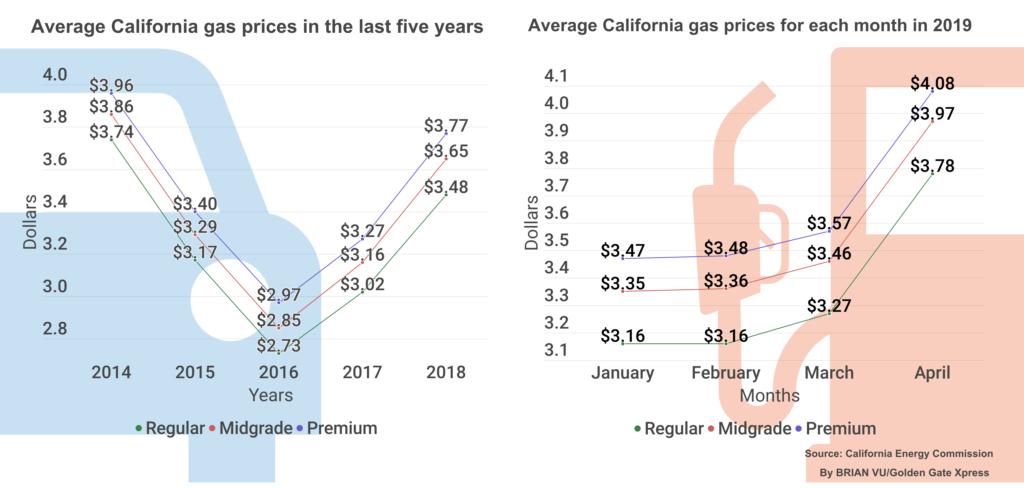INFOGRAPHIC BY BRIAN VU with reporting BY AUDREY ESOMONU/Golden Gate Xpress
The cost of gasoline in California soared in April, with some San Francisco gas stations charging more than $4 per gallon, according to the U.S. Energy Information Administration.
This increase will most likely affect individuals in lower-income communities as well as students, according to Bay Area Economic Institute research analyst Isabel Monteleone.
Monteleone said California’s gas tax and strict environmental laws played a role in rising gas prices.
Western States Petroleum Association President Catherine Reheis-Boyd disagreed, and said the rise in prices is associated with supply and demand.
“Over the past several decades, fuel costs in California have been subject to dozens of independent inquiries by government agencies, all of which concluded the dynamics of supply and demand are responsible for movements in the price of gasoline and diesel fuel,” Reheis-Boyd said. “In addition, many ever-changing factors, including the higher cost of producing CARB gasoline and state programs, such as cap-and-trade and the Low Carbon Fuel Standard, impact fluctuations in energy markets.”
The Cap and Trade program limits the level of emissions from chemicals and the Low Carbon Fuel Standard program is meant to advocate for cleaner and low-carbon fuels in California.
On April 22, Gov. Gavin Newsom wrote a letter requesting an investigation that could explain the rise in prices by May 15.
“Independent analysis suggests that an unaccounted-for price differential exists in California’s gas prices and that this price differential may stem in part from inappropriate industry practices,” Newsom said in the letter.
Students who commute to SF State are already feeling the effects of rising gas prices. Hospitality and tourism management major Kristinn Bour commutes to San Francisco three days a week from Lake County, two hours north of the city. When she heard the news about the cost of gas, she said she was upset because she may have to reconsider her living situation.
“I was so mad because I realized that I either have to move closer to the city or get a full-time job,” Bour said. “I was shocked. It was not something that I wanted to hear.”
Bour said while the gas prices won’t stop her from studying at SF State, she already has a tough time attending classes when she spends about $60 a day on gas.
“Last week I only had one class, all my other classes got canceled, and I didn’t go to school all week because I was like, ‘What’s the point of going to school for one class for an hour?’ I could save that $60 and put it towards bills and groceries,” Bour said.
For other students, the increased gas prices have been an added stressor as well. Political science major Aileen Rodriguez said she was infuriated when she heard the news.
“As a student, having extra money for gas is very inconvenient for me, especially since I have to budget throughout my week,” Rodriguez said. “So the gas rising also makes me cut back on other expenses.”
Since Rodriguez works on campus, she only gets paid once a month. The increase in gas prices has made her careful about what she’s spending money on.
“It cuts back on food expenses and extra necessities I need throughout the month,” Rodriguez said. “I don’t fill up my tank all the way because that’s too expensive, so I’ll put $20 [in] and I have to make that last.”
Other students, such as child and adolescent development major Fabiola Perez, face similar challenges.
“I have to limit myself on what I buy—it’s very expensive and it’s not convenient,” Perez said. “It sucks that I have to pay so much to get to class. I take BART sometimes, but it’s not the safest or cleanest.”
Though many people would not want to see an increase in prices at the pump, it can have a positive impact on the environment, according to Monteleone.
“Higher gas prices may also lead to lower gas consumption, which can help the state reach its environmental goals,” Monteleone said.







